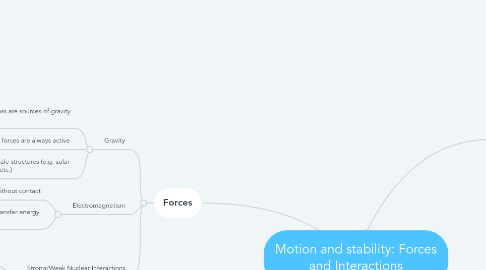
1. Forces
1.1. Gravity
1.1.1. Objects with mass are sources of gravity fields
1.1.2. Gravitational forces are always active
1.1.3. Govern large-scale structures (e.g. solar system, galaxy, etc.)
1.2. Electromagnetism
1.2.1. Can occur without contact
1.2.2. Force fields contain and transfer energy through space
1.3. Strong/Weak Nuclear Interactions
1.3.1. Structure, property and transformation of matter are explained by attraction/repulsion of electric charges
1.3.2. Strong and weak interactions determine nuclear size, stability and rates of radioactive decay
2. Forces between objects describe how their motions change
2.1. Also help predict stability or instability
2.2. Interactions between two objects can cause changes in one or both objects
2.3. Force is mass times acceleration
2.4. Momentum is mass times velocity
2.5. Momentum is a conserved quantity
3. Interactions between objects
3.1. Objects acting on each other have both strength and direction
3.2. Even objects at rest have multiple forces acting on it
3.3. Strength of forces can be compared
3.4. Forces on an object can change its shape and orientation
4. Prediction
4.1. Stability vs. Instability
4.1.1. Stable: internal and external forces help return that system to its prior state
4.1.1.1. System can be stable but changing (e.g. orbits of the solar system)
4.1.2. Depends on the balance of competing effects
4.1.3. Changes in conditions can change the stability of an object
4.1.4. Static: non chaning/Dynamic: changing
4.1.5. unstable systems will continue to change until it reaches a stable configuration

